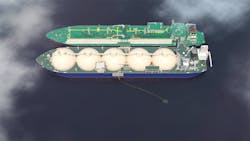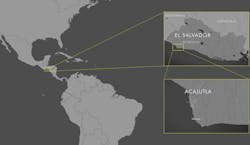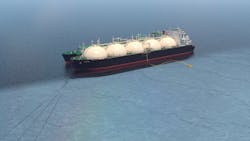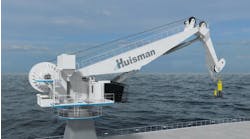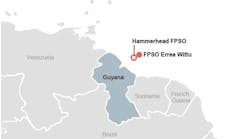Energía del Pacífico project calls for region’s first regasification vessel
Alberto Osorio Liebana, Invenergy
Emerging economies continue to record sharp increases in energy demand, and the floating storage regasification unit (FSRU) concept has demonstrated that it can deliver a fast and cost-effective solution.
The first FSRU unit was installed in the Gulf of Mexico in 2005, and by mid-2016, 19 more were in operation. According to the publication, “Natural Gas and the Clean Energy Transition,” produced by the International Finance Corp., a sister organization of the World Bank, countries have turned to FSRUs primarily for three reasons: needing LNG for a secure supply of natural gas, using LNG to provide back-up to hydroelectricity, or making up for declining gas reserves.
By the end of 2018, there were 40 LNG-importing countries, and almost all new importers are emerging markets that have developed FSRU-based terminals. In some cases, FSRU projects are serving the rapidly increasing gas-to-power market in places where there is no access to existing gas infrastructure.
Powering El Salvador
Energía del Pacífico (EDP) is an ambitious project that is introducing a new, clean, and more efficient source of energy to El Salvador, where most power generation today is fueled by heavy fuel oil (HFO). The goal of the EDP development is to expand El Salvador’s energy mix, adding LNG to the current hydropower, geothermal, solar, and HFO sources to provide consistent and reliable energy.
The project – which is being executed via a partnership headed by Invenergy and supported by El Salvador-based partners Grupo Calleja, VC Energy de Centroamerica and Quantum Energy – includes an FSRU that will transport regasified LNG via subsea pipeline in the Port of Acajutla to a newly constructed 378-MW thermal power plant onshore. This new facility will meet 30% of El Salvador’s energy demand. A 44-km (27.3-mi) transmission line and substations also are part of this development, which constitutes the largest private investment to date in El Salvador.
Rising to the challenge
Laying the groundwork for this technically complex project did not come without challenges. In addition to introducing the first LNG-fueled power plant to El Salvador, this project includes the first FSRU for the region. Regulations needed to be formulated and approved for offshore gas storage as well as for transportation to shore. The scope of the transmission network expansion was another challenge because rights-of-way negotiations had to be finalized before construction could begin.
Another challenge was designing the physical components of the project – the supply, storage, and regasification of LNG; the power plant; and a transmission network – all of which required creative technical solutions.
Introducing a novel concept
Initial development concepts included onshore regasification and LNG tanks, a jetty, and an offshore FSRU barge protected by a near-shore cofferdam. Located close to shore in 17-m (56-ft) water depth and exposed to open ocean swell, these options became very expensive and potentially rendered the project unviable. In the end, the most practical and cost-effective solution was a permanently moored FSRU.
The team procured the Gallina Moss LNG carrier from Shell and contracted BW LNG to carry out the FSRU conversion. The FSRU will be moored on the Pacific coast of El Salvador, orientated at approximately 225° to minimize waves on the starboard bow and to position the mooring lines from the stern of the vessel to avoid interfering with pipelines. The vessel position was chosen to minimize interference with other port infrastructure, port traffic and anchorage areas and place it outside the nearby buoy moored oil importation terminal exclusion zone and out of the way of the associated marine terminal operations.
The FSRU is designed with 137,000 cubic meters of storage and 280,000,000 scf/d of regasification capacity which is four times the throughput needed to meet the maximum power plant capacity providing a high level of reliability and redundancy. The FSRU will receive LNG from ship-to-ship (STS) deliveries from LNG carriers (LNGC) that will be supported and maneuvered alongside FSRU by tugboats from SAAM Towage. The LNGC is berthed to the FSRU, positioned along the starboard side. LNG is transferred between the LNGC and FSRU via their mid-ship manifolds using cryogenic hoses. The LNG is regasified onboard FSRU, and gas is delivered to shore from the regas manifold on the FSRU via a riser from a port side porch, to a pipeline end termination connecting to a 1,750-m (5,741-ft) subsea pipeline to the onshore power plant.
EDP has signed a long-term supply agreement with Shell to supply LNG for the development for around 13 years.
Designing the mooring system
An affordable mooring system that could permanently moor an FSRU for 20 years in 17 m (56 ft) water depth was needed to allow the project to move forward. The main objective was to design a mooring system that provides uninterrupted transfer of gas from the FSRU for both operational and extreme conditions.
The installation site of the FSRU is south of the hurricane/tropical cyclone belt in an area with relatively benign environmental conditions. However, the vessel would be exposed to seasonal long period swell and possible seismic activity with the potential to create tsunamis. The design environmental conditions considered most severe scenarios in 100-year wave, wind, and current conditions and extreme 1,000-year events for tsunamis, including sea level variations as well as current speeds.
Nominal 100-year conditions include:
• 100-year significant wave height of 3.3 m (11 ft) with peak periods of 12 to 18 sec
• 100-year wind speeds of 20 m/sec (1 hour mean)
• 100-year surface currents of 1 m/sec.
CAN Systems in Norway developed and designed the restricted catenary mooring (RCM) system, a refined spread mooring system that comprises a bow mooring system, a mooring restrictor arrangement and stern hold back lines. The main feature of the RCM system is a specialized, subsurface connecting plate and restrictor arrangement that keeps the mooring lines at the bow and stern close together below keel level, thereby preventing the mooring lines from interfering with the offloading LNGC.
The RCM system consists of the bow mooring system secured by chains affixed to connecting plates arranged from deck level hangoff with restrictor chains to hold the mooring lines together and away from STS moored LNGCs to avoid interference during offloading. The holdback lines at the stern have a similar arrangement as the bow mooring lines. The flexible 14-in. gas export riser is routed from a balcony at the side of the ship to the pipeline end termination (PLET) on the seabed where it transitions to the pipeline that carries the gas to shore.
The seabed where the FSRU will be moored is relatively sandy with the presence of volcanic boulders, which led to the selection of the Vryhof Stevshark REX drag embedment anchor for the mooring system. The REX anchor is designed with spread shanks and a geometry that improves installation, penetration, stability, and strength. The RCM mooring system consists of 84-mm chain for the lower anchor legs and 100-mm chain in the top chains for additional corrosion allowance in the splash zone (above the restrictor chain). Mooring legs have variable lengths from 135 m (443 ft) to 235 m (771 ft) to fit within the site restrictions. The Vryhof Stevshark Rex anchors vary in weight from 12.5 tons to 23 tons including extra ballast weight.
Model testing to confirm the RCM design in 100-year wind, -wave and -current design conditions was carried out by MARIN in the Netherlands. Tests also evaluated LNGC alongside the FSRU in STS loading conditions as well as additional scenarios to determine the mooring capacity in conditions in which any single component in the station keeping/mooring system is lost.
Further simulations were performed with the most loaded line removed and with the second most loaded line removed. The results from the simulations form the basis for the line-broken line tensions and FSRU offsets. For these single-component failure scenarios, the criterion for peak loads in the remaining anchor lines and 100-year extreme condition loads is defined by API RP 2SK – the industry standard for mooring systems. CAN Systems also conducted simulation and modeling to validate mooring performance for tsunami conditions.
The validated mooring arrangement was verified and approved for use on the EDP project by classification society DNV GL.
Effecting positive change
The 378-MW EDP project in El Salvador will not only introduce a new source of energy to the country, but it will also include the development of the first offshore regasification vessel deployed off the Pacific Coast of Central America – thus demonstrating the viability of floating LNG as an energy source for land-based power generation in the region.
EDP is a transformational project for El Salvador and Central America as a whole, introducing a new source of energy with a system that provides the efficiency and flexibility to supplement varying production from solar and hydro generation sources. This added capacity will not only balance energy availability but will also reduce the environmental impact of energy production. Beyond the added benefits to the energy mix and environment, the project is a catalyst for growth for the country. •
The author
Alberto Osorio is Director of Thermal Engineering at Invenergy and Project Director of the Energía del Pacífico (EDP) project, currently under development and construction in Acajutla, El Salvador. In this role he is responsible for leading and coordinating all project activities including EPC contractor management. He holds a BS in Civil Engineering from the University of Granada, Spain; a BS in Civil Engineering from the National Autonomous University of Mexico; and an MS in Engineering of Roads, Canals and Ports from the University of Granada, Spain. He is a licensed professional engineer in Spain and Mexico.
